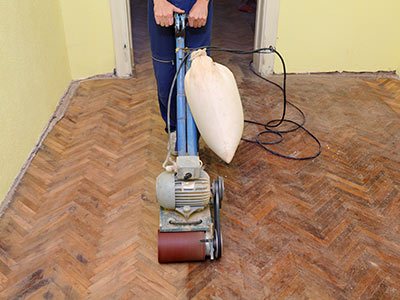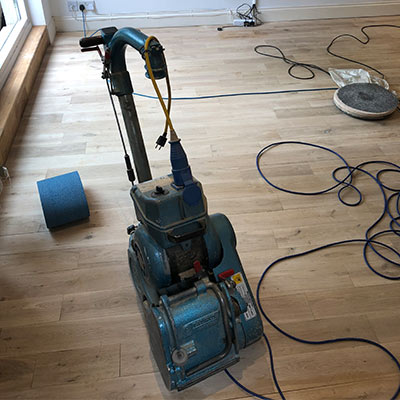Back to Floor Sanding
Common Mistakes to Avoid When Sanding Wooden Floors
 Sanding wooden floors is a great way to update your home and add value. However, if done incorrectly, it can be costly and time-consuming to repair the damage. To ensure that you sand your flooring correctly, here are some common mistakes to avoid when sanding wooden floors. From using the wrong grit of paper to not cleaning up properly afterwards, this article will provide helpful tips for getting it right the first time around. With these tips in mind, you'll be able to give your wood floors a beautiful finish without any costly mistakes!
Sanding wooden floors is a great way to update your home and add value. However, if done incorrectly, it can be costly and time-consuming to repair the damage. To ensure that you sand your flooring correctly, here are some common mistakes to avoid when sanding wooden floors. From using the wrong grit of paper to not cleaning up properly afterwards, this article will provide helpful tips for getting it right the first time around. With these tips in mind, you'll be able to give your wood floors a beautiful finish without any costly mistakes!
Not properly preparing the floor before sanding
One of the biggest and most essential steps is ensuring that the floors are properly prepared before sanding. Failing to do so can lead to uneven sanding and an overall unsatisfactory finish. This means that any loose nails or screws should be removed, any gaps or holes should be filled, and any protruding objects should be trimmed. By taking the time to properly prepare the floor, you can ensure that the sanding process will be much smoother and more successful in achieving the desired results.
Skipping grits in the sanding process
Another mistake to avoid is skipping grits in the sanding process. While it may be tempting to jump to a finer grit in an effort to save time, it can actually prolong the process and compromise the final result. Starting with coarse grit and progressively moving to finer grits allows for the removal of deeper scratches and a more refined finish. Take the time to properly sand your wooden floors to achieve a flawless result that will last for years to come.
Using the wrong type of sandpaper
Using the wrong type of sandpaper can be a costly mistake. It's important to select the appropriate grit for your specific flooring type and the desired level of sanding, whether you're removing old finish or smoothing out rough spots. Using grit that's too coarse or too fine can result in uneven sanding and even damage to the wood. Additionally, make sure you're using high-quality sandpaper that won't tear or wear out too quickly during the job. With the right sandpaper and technique, you can achieve a beautiful finish for your wooden floors.
Applying too much pressure when sanding
 One of the most crucial mistakes is applying too much pressure when sanding. Although it may seem like a good idea to apply more pressure in order to get the job done faster, it can actually cause irreparable damage to the wood. Too much pressure can cause uneven sanding, damaging the surface of the floor and creating rough patches that are difficult to repair. To avoid this mistake, it is important to use light and consistent pressure while sanding, allowing the tool to do the work and avoiding any unnecessary damage to the floor.
One of the most crucial mistakes is applying too much pressure when sanding. Although it may seem like a good idea to apply more pressure in order to get the job done faster, it can actually cause irreparable damage to the wood. Too much pressure can cause uneven sanding, damaging the surface of the floor and creating rough patches that are difficult to repair. To avoid this mistake, it is important to use light and consistent pressure while sanding, allowing the tool to do the work and avoiding any unnecessary damage to the floor.
Not vacuuming between sanding passes
It may seem like a trivial step, but neglecting to remove sawdust and debris can create an uneven surface, and impact the stain absorption and overall finish. The residue can become embedded in the wood fibres and make it challenging to remove later. To avoid this mistake, it's recommended to use a high-quality vacuum with a HEPA filter, ensuring all particles are completely removed after each pass. By taking a little extra time to vacuum, you can achieve a perfectly smooth and professional-looking hardwood floor.
Not using a sanding sealer
Using a sanding sealer is a crucial component in achieving a smooth, even finish. The sealer acts as a barrier, preventing the wood from absorbing the stain or finish too quickly, resulting in an uneven appearance. Additionally, the sealer can enhance the adhesion of the finishing coat, ensuring a longer-lasting finish overall. Skipping the sanding sealer could ultimately lead to a less durable and less attractive final product. To ensure a professional-looking result, don't forget to use a sanding sealer in your wood floor sanding project.
Not allowing enough time for the sealer to dry
While it may be tempting to rush through the process, allowing the sealer to dry completely is very important to ensure a smooth and even finish. Failing to do so can lead to an uneven surface and can even cause the sealer to peel or crack. To avoid this mistake, be sure to follow the manufacturer's instructions for drying time and resist the urge to sand too soon. Take the time to properly prep and finish your floors, and you'll be rewarded with beautiful, long-lasting results.
Not buffing between coats of finish
Buffing is an essential step that smooths out imperfections and ensures adhesion between layers of finish. Skipping this step can result in a rough and uneven surface, as well as poor durability and the potential for premature wear and tear. To achieve a beautiful and long-lasting finish, it is crucial to take the time to properly buff between coats of finish.
Applying too many coats of finish
One major mistake to be aware of is applying too many coats of finish. While it may seem like more coats will provide a better finish, in reality, this can lead to a thick and uneven layer that is prone to peeling and chipping. Not only does this create an unsightly appearance, but it also wastes time and money. It's essential to follow the manufacturer's instructions carefully and apply only the recommended number of coats to achieve the best results. Don't let the temptation to over-apply the finish ruin your hard work - stick to the guidelines and enjoy a beautiful, long-lasting finish.
Not allowing enough time for the finish to cure
It may be tempting to rush the process and move furniture back into the room or start using the floor again, but doing so can seriously compromise the quality and durability of the finish. The curing process is critical for ensuring that the finish hardens and adheres to the wood properly, so it's important to follow the manufacturer's recommendations and give it the necessary time to cure fully. Taking shortcuts here may save time in the short term, but can lead to costly repairs and refinishing work down the road. As a professional, it's important to educate your clients on this aspect of floor sanding to help them understand the importance of patience and allowing the finish to cure completely.